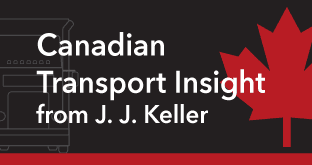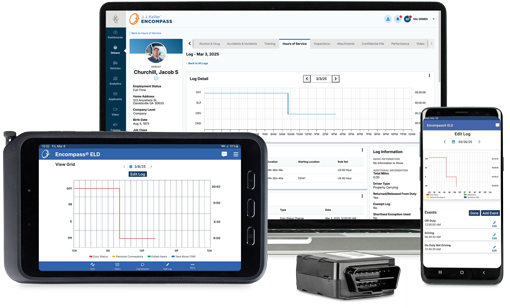Industry Business Advisor — J. J. Keller & Associates, Inc.
Canada's ELog Mandate & Hours of Service FAQs
Canada’s electronic logging device (ELD) mandate became effective for all federally-regulated carriers starting on June 12, 2021. Read this blog for more details on the difference between the U.S. and Canadian mandate rules.
Published On: 04/15/2024


Written by:
Mark Samber
Canadian Electronic Logging Device Mandate FAQs
Q. WHAT IS THE COMPLIANCE DATE FOR CANADA'S ELD MANDATE?
A. The federal mandate was effective on June 12, 2021 for federally regulated carriers with the educational period ending and enforcement beginning January 1, 2023.
Q. WHO MUST COMPLY WITH CANADA'S ELD MANDATE?
A. Federally regulated carriers based in Canada that are not exempt must comply with the ELD mandate. All provinces and territories except Alberta, Saskatchewan and Nova Scotia have also mandated ELD’s be used by intra-provincial carriers.
U.S.-based carriers operating in Canada are also subject to Canada's ELD mandate. As a result, U.S.-based carriers must use Canadian-certified ELDs when operating into Canada.
Q. WHAT DOES IT MEAN WHEN THE ELD RULE STATES THAT CANADA REQUIRES THIRD-PARTY CERTIFICATION OF ELDS?
A. A person or an entity can apply to Canada's Minister of Transport for accreditation as an ELD certification entity. The person or entity must:
- Verify that they meet the International Organization for Standardization standard ISO/IEC 17065, "Conformity assessment — Requirements for bodies certifying products, processes, and services";
- Verify that they are knowledgeable about the ELD Technical Standard; and
- Confirm the validity of their certification methodology.
Accreditations are valid for five years.
ELD providers submit their devices to the person or entity for testing and certification. A list of certified ELD providers will be posted on Transport Canada's website. There are currently two certification bodies: FPInnovations and COM Driver Tech.
Q. WILL FMCSA SELF-CERTIFIED ELDS COUNT AS CERTIFIED FOR CANADA?
A. No. The Federal Motor Carrier Safety Administration (FMCSA) requires ELD providers to self-certify that their devices meet U.S. regulations. This is not the same as a third-party certification and is not accepted in Canada.
Q. WITH THE ADOPTION OF THE ELD MANDATE IN CANADA, WERE THERE ANY CHANGES TO THE HOURS-OF-SERVICE LIMITS?
A. No. The hours-of-service limits remain the same. Transport Canada made technical amendments to the regulation, which involved clarifying the on-duty time definition, loosening up the 160-km log exemption recordkeeping requirements (although the individual jurisdictions can require more detailed recordkeeping), and updating the definition of a commercial motor vehicle. Transport Canada also more clearly defined what constitutes a supporting document under the regulation, but none of these updates affect hours-of-service limits.
Q. WILL U.S. CARRIERS THAT OPERATE INTO CANADA BE REQUIRED TO COMPLY WITH CANADA'S ELD MANDATE?
A. Yes. While many of Canada's technical specifications are nearly identical to the U.S. ELD specifications, Canada differs in a few areas. This means that U.S. carriers operating into Canada will need to comply with those differences. For example, U.S. carriers into Canada will need to ensure their ELD providers have secured third-party certification of their ELDs, and again, that drivers are using only certified ELDs when operating into Canada.
General Canada HOS FAQs
Q. WHICH CYCLE SHOULD A U.S.-BASED DRIVER CHOOSE WHEN OPERATING INTO CANADA?
A. Many carriers operating into Canada from the U.S. choose the 70 hour/7 day cycle because it is closest to the cycles in the United States. Generally, U.S. drivers operating into Canada under the 70 hour/7 day rule will be in compliance if they are in compliance with either the 60 hour/7 day or 70 hour/8 day cycles in the United States, as these cycles are more restrictive.
Q. DOES CANADA HAVE REGULATIONS SPECIFIC TO PASSENGER CARRIERS?
A. The Canadian hours-of-service regulations do not differentiate between property-carrying and passenger-carrying carriers.
Q. DOES THE REQUIREMENT TO HAVE 24 HOURS OFF DUTY AT SOME POINT WITHIN THE PREVIOUS 14 DAYS APPLY TO U.S. DRIVERS?
A. Yes. Upon entering Canada, a U.S. driver should be prepared to show at least 24 consecutive hours of off-duty time at some point within the previous 14 days.
Q. MUST U.S. DRIVERS OPERATING INTO CANADA PRESENT THE PREVIOUS 14 DAYS' WORTH OF LOGS?
A. Yes. U.S. drivers must carry or display 14 days' worth of logs while in Canada.
Q. WHEN OPERATING IN CANADA AND USING THE VEHICLE AS A PERSONAL CONVEYANCE, MUST A U.S.-BASED DRIVER COMPLY WITH CANADA'S PERSONAL USE LIMITS?
A. Yes, while in Canada, Canada's personal use provisions apply. Drivers are limited to 75 kilometers of personal use travel per day, the vehicle must be empty, and trailers must be unhitched. The starting/ending odometer readings of the personal use must also be recorded on the daily log.
Upon entering Canada from the U.S., if the driver's use of personal conveyance in the U.S. does not meet Canada's requirements, it will result in the time being changed to on-duty time or driving time and the on-duty time/driving time/cycle and will be recalculated accordingly. Enforcement will not consider the log falsified due to the change, as the record was true and correct when the driver was in the United States. Learn more about Canada's personal conveyance rule here.
You may also enjoy the following articles:
Sign up for our newsletter!
We'll help you stay on top of regulations, best practices, and fleet industry news. Sign up to receive a monthly email notification with links to our most recent blog articles, free resources, and event invites.
